|
|||||||||||||||||||
|
|
|||||||||||||||||||
|
|
Results from Survey given in March 2006
There were 364 responses.
This is the best response rate for a MAST survey (317 in 2002, 315 in 2003, 288 in 2005).
321 or 88% of the responses were from non-STScI employees
33 or 9% of the responses were from STScI employees
10 or 3% of the responders did not answer this question
We solicited responses from all subscribers to the Archive Newsletter, those who had a GALEX CASJobs account, and to all those who had retrieved data from DADS in the previous 24 months. We also placed an invitation to participate in the survey on the MAST web pages.
With questions 1 through 7, we asked questions to characterize MAST usage and to determine the platforms and browsers MAST users are utilizing. The remaining questions attempt to solicit input concerning various tools and services MAST has either implemented or may plan to implement in the future. We provided several places for responders to enter comments and suggestions. We have selected a subset of the comments and included them in this summary. If several people had the same or similar response, we have only included one of them. In some cases, similar comments were included in two different comment fields. We would like to respond to some of the suggestions and comments. That response has been compiled in a separate web page. In some respects we find the comments the most useful part of the survey. We would really like to get these throughout the year as you discover needs or have questions. You may send suggestions to the archive help desk at archive@stsci.edu or call at 410-338-4547 between 9:00 AM and 5:00 PM eastern time. You may also wish to use the MAST Suggestion Box.
1. How often have you used MAST in the past 12 months?
| Fewer respondents are using the MAST archive several times a month while more are using it several times a year. Shift of usage from several times a month to several times a year may reflect an increase in Archival research as opposed to dealing with their own observations. |
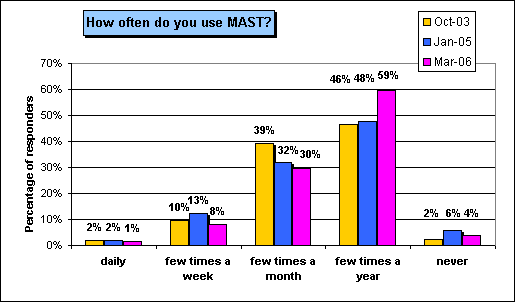
|
3. What missions did you access? (multiple choices permitted)
The number of respondents who report that they use HST data has remained relatively steady. GALEX has shown an increase in reported usage, probably due to the availability of Data Release 1 and Guest Observer data. Usage of other missions seem to have fallen, although considering that many of these are longtime legacy data collections usage is still good . Due to spacecraft operations problems, FUSE did not acquire much new data during the past year and this may explain the drop off of FUSE usage. |
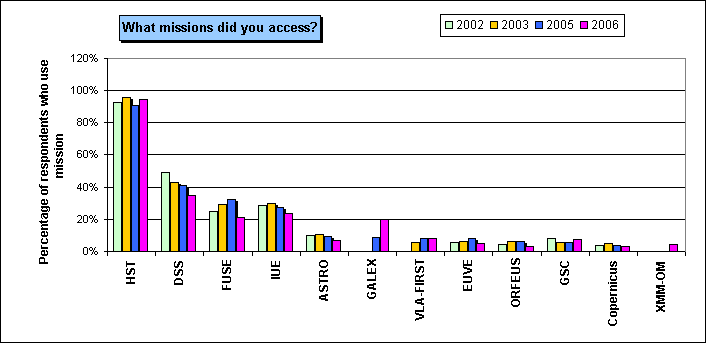
|
4. Which operating system do you primarily use to access MAST?
| Linux use was steady, while OS X usage increased by 10%. There has been a significant drop in the use of the Solaris platform. |
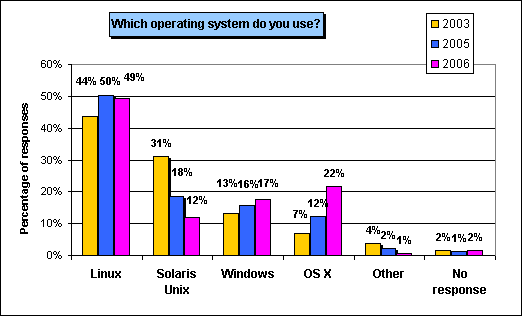
|
5. Which browser do you primarily use for your work?
|
Use of the new browser Firefox increase dramatically, with Safari also showing an increase in usage.
Usage of these two browsers seem to have grown at the expense of Netscape/Mozilla.
|
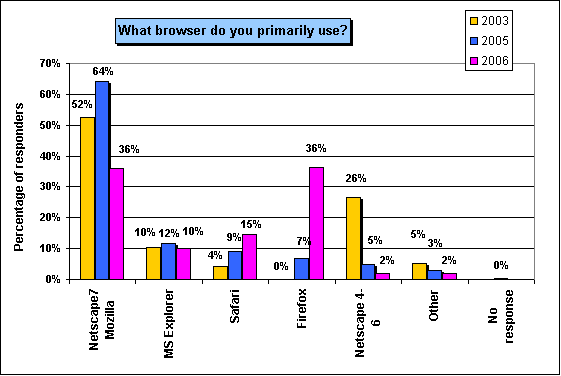
|
6. For what reasons do you use MAST? (check all that apply)
| Obviously most MAST users utilize it for scientific research. There are several people who use the archive for educational purposes or to make their own space pictures. we need to know what other reasons MAST is used for. |
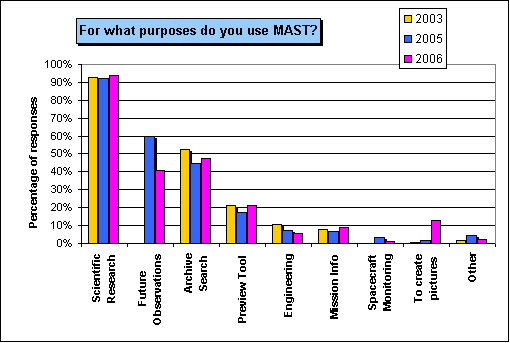
|
7. What is your primary and most common reason for using MAST?
| Even among STScI employees, Scientific Research was the primary reason for using MAST. Twenty of the 32 (62%) STScI employees who responded to the survey stated that Scientific Research is their primary reason for using MAST. |
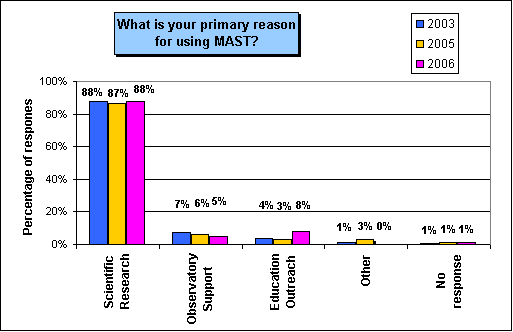
|
8. Which kind of documentation about MAST have you used in the past 12 months?
| MAST has all three types of manuals, although the written archive handbook is out of date. We have tried to include easy links to documentation including from the search pages and search result pages. |
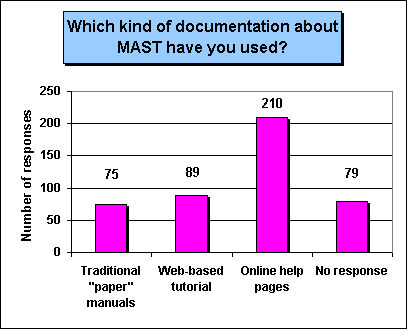
|
Comments :
- Help pages don't always provide the information that they should.
- I prefer to learn about MAST by looking at the web forms.
- contextual help is best
- I usually don't read the manual, but snoop around; I usually know what I want.
- As many users I usually have no time to read manuals so web interfaces that are 'self explanatory', as MAST is, are great!
- I find all kinds are useful, depending on the purpose.
- Didn't even know that there was a tutorial or a manual.
- I found the tutorial 'easy to use'
- Haven't consulted any documentation
- not used any
9. Which of the following have you used in the past 12 months for learning about new features or developments at MAST?
| Most people seem to have learned about MAST features through browsing the web site. |
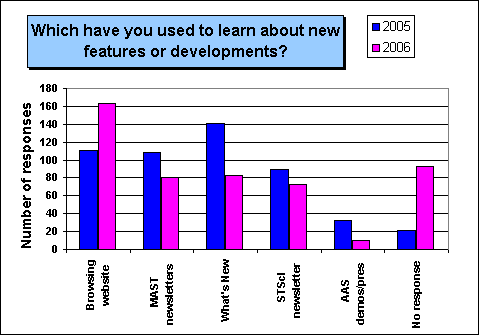
|
Comments about learning about new features or developments at MAST:
- discussions with colleagues and friends.
- E-mail notification of 'What's new' (separate from STScI newsletter).
- Keep the chatter to a minimum. I already get too much email.
- MAST people speak at user's groups meetings.
- I just deal with them as they come.
10. Which of the following best describes how useful you find MAST's High Level Science Products?
| We concluded from some of the responses to this question that people did not understand that High-Level Science Products are community contributed products which are fully processed (reduced, co-added, cosmic-ray cleaned etc.) images and spectra that are ready for scientific analysis. HLSP also include files such as object catalogs, and spectral atlases. |
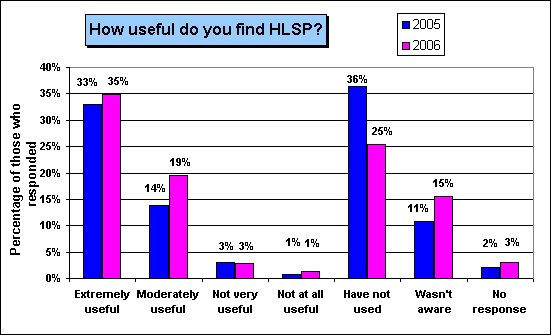
|
Comments :
- These products are very helpful and an important part of the archives
- I would suggest to offer more High-Level Science products, which are ready to use for scientific work. Of course, this will take a lot of money/time to provide these data, but will definitely save the same for the users. In my opinion, it does not make sense that every user has to download raw data to proceed all the data by his own, if someone else has done it already properly. To save resources, you can ask the PI's of finished programs to send the final data back to you, after they have published all their work. They can earn also acknowledgements/citations or even publications for providing the data.
- It would be VERY useful if it were described which kind of data IS, and which kind of data is NOT part of the HLSP
- In the description of the ACS GOODS observations a planned new release was mentioned, which so far did not happen.
- Excellent job distributing UDF data! You should make all your data distribution up to that standard.
11. Which of the following features from the MAST/GALEX web site have you used in the past 12 months?
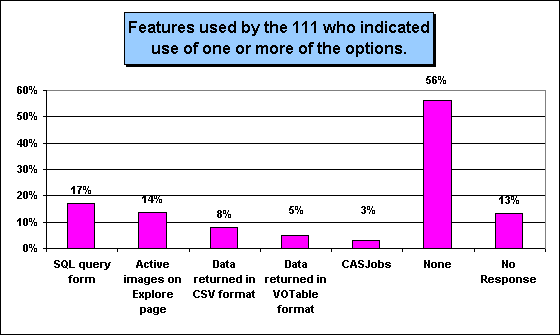
|
|
There were 67 people who responded to this question who did not indicate that they had used GALEX data. The plot below shows the responses for those who indicated that they had used GALEX data.
|

|
Comments:
- I would have used the SQL query form, but did not know there was one- I'm looking now, and can't easily find it... the web page could use better overall navigation.
- Horrible situation with ftp scripts. Still haven't downloaded all my data!
- my galex downloads were done by a student
- Actually getting Galex data is very confusing. For simple science why can't I just click on your processed galex image and get a fits file with that data (instead of a link to 200 scans which it's hard to figure what to do with).
- The GALEX archive should show whether an observation was made at the RA and Dec of the query, not just whether an object was cataloged there. The limitations and lack of astronomer-friendliness of the GALEX search interface has literally prevented me from using GALEX data or from proposing to get more. How can I propose to do an observation if I can't tell what has already been done in that part of the sky?
12. Which of the following VO services have you used?

|
Comments:
- I think that the money spent on VO should be kept small relative to the money spent on actually providing telescopes. The VO stuff is likely to be useful, but should be scoped to fit within astronomy's actual budget situation. It would be far more important to me to see HST's lifetime extended than to see some vast amount of effort going into improvements over what MAST already offers. Sorry.
- I haven't used any VO tools and was unaware that there were any
- really should start trying to understand the VO protocols (there were 4 similar comments).
- I don't find this stuff very useful yet. ( There were 3 similar comments)
13. If you use scripts to access MAST data and/or catalogs, please list the languages(s) used and the purpose of the script.
| There were 26 responders who indicated that they had used scripts and who also gave language and/or purpose. | |
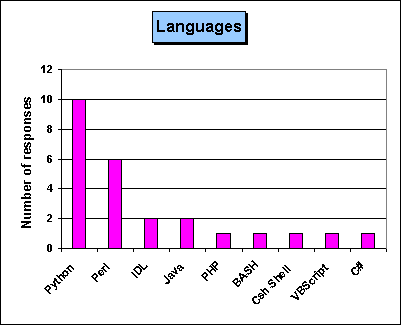 |
|
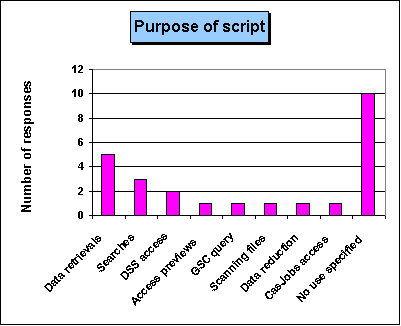 | |
14. Would you be more inclined to use scripts if we gave examples for how they could be used to access the MAST archive?
| The response to this question was enthusiastic so we will evaluate how to best provide examples of scripts to access MAST Searches and data via scripting languages in the next year. If you have already written an example and are willing to share, please contact us via the help desk or our suggestion box. |
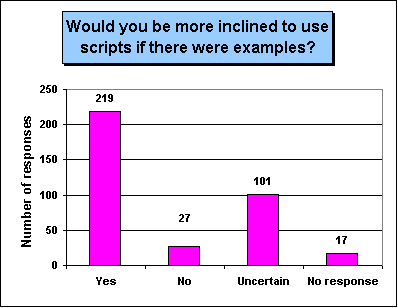 |
15. MAST and STScI are currently pursuing plans for the Hubble Legacy Archive (HLA) with fast data access through MAST and VO tools. Proposed new features include immediate access to calibrated HST data, improved astrometry, footprint services giving accurate image boundaries, image cutout services, and object catalogs. Does this sound useful to you?
| There was a high level of interest for the HLA from the survey respondents. |
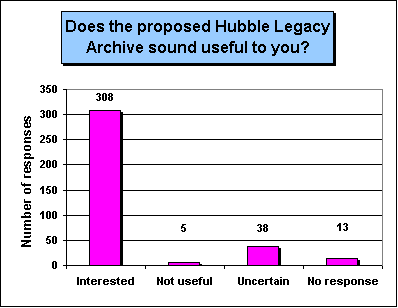
|
Comments: Please see response page.
- It would be great to be able to pull out of the archive drizzled,
combined ACS images. Of course, this is difficult, because where do you
draw the line on what data belongs to which data set? Along the same
lines, have you thought of GRID-style reduction of HST imaging? WFPC2
and ACS reduction is very straightforward, so it could be done on the
STScI machines and only the result forwarded to the user, since that's
all the user cares about.
- Search support for solar system/ moving targets is rather spotty. Right now you are pretty much limited to using the target description field. Would really like to see the capability to perform a search on moving Solar System objects and/or moving targets. There were 2 additional comments concerning solar system search support.
- preview for ACS images from the web-interface VO access (SIAP) to calibrated ACS/WFPC2 data
- Would the data include source lists for each field? Those of us working in other spectral bands would find it very useful if we could pull up data with point sources already marked or somehow identified for the field e.g. to see if x-ray sources in the field have optical counterparts and for checking astrometry.
- Plotting of spectroscopic slits as overlays on DSS or HST images
- Direct access to final spectra/images obtained by co-addition of several similar observations (same object with same instrument setting).
- easily downloadable ascii tables. ( There were several comments about desire for ASCII tables.).
- Anything that gets to the target faster and provides the correlated data is going to be very useful.
- access to combined, processed images
- Improvements to the absolute astrometry of data products (especially HST data) would be the most useful feature for my research.
- Just improve EXISTING functions without worrying about developing others. MAST downtime and retrieval times remain too long!
16. What other data centers do you access regularly?
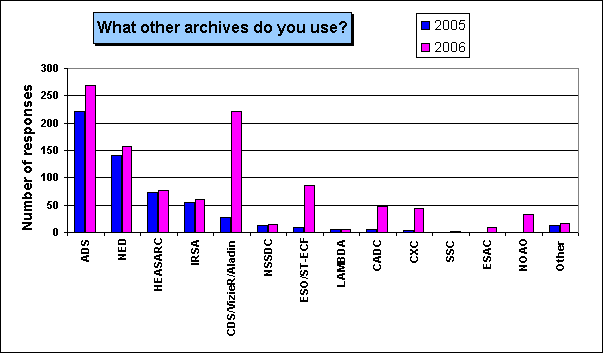
|
At the end of the survey we asked two questions. Responses to these two questions overlapped. We have attempted to consolidate, summarize and group comments. Not all comments have been included. Please see the response page for some answers or explanations related to some comments.
General Comments
- MAST stands out for its ease of use. There were around 40 similar responses. Thank you
- Please ensure that, if possible, access remains open via standard HTML -- at least as an alternative to things like JavaScript/AJAX or Java applets, if the latter are used in the future. (I.e., please *don't* go the route of the ISO archive, which only has access via a Java applet).
- Continue to cover a large range of missions, and consider including ground-based data. The joint ESO/HST search at ESO/ST-ECF is a good example. Perhaps also consider a joint HEASARC/MAST search (or with Vizier). But I guess this would be called a Virtual Observatory...
- It would be a nice if we could be given simple examples of using scripts to access archival information for the purpose of extracting large amounts of data for large surveys. I'm not sure what the ultimate plan is for the Virtual Observatory, but it would be exceeding nice if that plan included having archival data linked to databases such as GSC and NED to show all identified point sources for that field and match each source identified for that field with a hyperlink to bring up the relevant information for that point source. This way point source identification doesn't have to be redone every time a field is loaded. This would save a tremendous amount of time. If ds9 could be modified to interact with the GSC and NED databases so that it could load the sources for a field based on the WCS present and if HST archival data contained a ds9 region file for identified point sources for each field, we could easily accomplish this by overlaying the region file on an image and have ds9 mark point sources from the various catalogs based on catalog coordinates.
- Generally, 'adding value' to 'science' products in a pipeline environment is a very undesirable contribution to lowering the quality of the science being produced. Indeed, these black-box pipeline data processes often contribute to erroneous scientific results. The raw data are the product of very expensive national resources and deserve a better legacy than being dummied down to 'least effort' black box products let alone analyses such as catalogs of 'objects' and related 'measurements' of those 'objects'. The $investment in archive facilities such as MAST would be much more productively invested elsewhere, despite the superficial, sexy selling points provided by 'science value added' products.
Operational Comments
- HST archive seems to be down a lot.
- Access to actual data products through MAST seems slower than for, e.g., Chandra or Spitzer archives (except for the HLSPs, which are very fast). This may have to do with the structure of the Space Telescope data archive, but the multi-hour delays are surprising given modern computing capabilities.
- Extremely easy to request and obtain data. DVD data retrival useful. If only other sources of data were as easy to view and obtain! Help desk always ready to advise if problems occur- very pleased with support. Please keep up this useful service to the scientific community. Greatly appreciated. Thank you.
- Some STIS previews of spectra are scaled automatically and often are dictated by a very strong emission line (lyman alpha) which makes the preview non-usable. Then the user has to use the additional option of formatting the scale of the preview. The preview should be scaled according mainly to the continuum (flux level of the continuum) rather than being scaled to the maximum flux which is most of the time a 'not-needed' emission line (often from earth glow!).
There were 5 references to this problem.
- It would be nice if the previews were calibrated and actually showed something other than a black box. As it is, the preview has to be saved locally, and opened with a viewer that works with fits files (I don't know if this is even possible).
There were 6 references to this problem.
- I wish that there weren't so many layers in the web site. Almost every time I go to the site it is to search and download HST data. I think that sometimes the desire for mission equality at MAST has resulted in HST being buried with every other mission.
- I find the search forms etc. always are too crowded with too many options and buttons - this is a visual impression of course, and I realize this is a consequence of a rich archive system.
- Would like to see the MAST/VizieR cross-correlated search capabilities improved (want all the options in the VizieR form available in from the MAST/VizieR search form).
- Some of the new MAST tools like the Vizier search tool don't seem to work well.
- If there was a way to directly get up on the screen the publications that were written based on a particular archived data set, that would be extremely useful. May have missed this if it already exists.
- It would be nice to be able: -to retrieve data for several objects at the same time instead of having to go through the entire process for each object - to select a sample (without knowing the names of the objects, for example all the galaxies classified as AGN with magnitudes between 17 and 18 in the ? band) and retrieve all the data at once
- This applies only to the Hubble part of your site. In general, I like the layout of the data returned from a search much more than the ESO site. The necessary data is laid out in a format that makes it easy to find the data that I need quickly.
- I like the association concept provided by CADC and ESO/ST-ECF, which greatly reduced the number of images returned for queries on popular HST targets, and thus allows one to find the 'right ones' much more rapidly.
- MAST operates more like a code-hacker's idea of an archive than an astronomer's. The new website is hard to navigate through and other archives including CXC and ESO's HST archive are easier to use.
- It would be good to be able to search on stellar spectral type (say you want all HST spectra of O type stars). I would also like to be able to search for all data covering a specific wavelength or wavelength range (e.g., search for all HST spectra covering the C IV doublet at ~1550 angstroms).
-
-
-
-
-
-
-
-
-
Comments from Amateurs and Educators
- Just keep up the superb work, the access times have significantly improved and the ease of use has made it possible to train students (graduate and undergraduate) in the use of spectroscopic data. This is an invaluable facility.
- Some of the masters projects I propose to my students are sometimes fully based on MAST.
- Better beginner, non-scientist, info on how to determine what sorts of files are with certain projects and how to search for them.
- Make it more user friendly for the non-professional researcher. Though i have done 4 papers at professional papers I do not find MAST to be user friendly!
- A service so that coordinates and image size can be entered into wikipedia (http://en.wikipedia.org), and turned into a link to this site, which gives an HTML page with a web-sized image (~640 pixels), and offers bigger images. Possibly automated colour images too.
- MAST is a little more difficult to use than some. Some information is blocked to me. I usually link to you thru a google link to a Hubble image. Thanks for the free looks now and again.
- Just keep the pipelines open and remember that not everyone who accesses this data is an astrophysicist.
- Take a look at the DSS Plate Finder and NED's pages and you will get a feel for high-productivity sites. When you have to download example files and browse readmes to determine what's going on, it takes away from effort.
- Super powerful and fascinating... difficult to use but I suppose that comes with the territory.
- Great and massively useful. Thank you.
|
|
|




 Follow Us
Follow Us